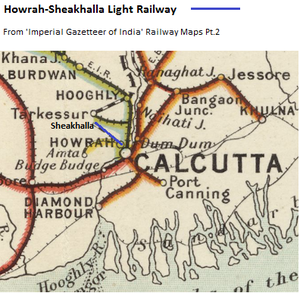Howrah-Sheakhalla Light Railway
| Howrah-Sheakhalla Light Railway | ||
|---|---|---|
| [[Image:|150px| ]] | ||
| Line of route | ||
| Howrah to Sheakhala | ||
| Gauge / mileage | ||
| 2' 0" NG | 20 miles (1905) 20 miles (1943) | |
| Timeline | ||
| 1898 | Line opened to traffic | |
| 1971 | Closed | |
| Key locations | ||
| Presidency | Bengal | |
| Stations | Howrah, Sheakhala | |
| System agency | ||
| Worked by Martin's Light Railways | ||
| How to interpret this infobox | ||
See also page Howrah Tramways (Light Railways)
The Howrah-Sheakhalla Light Railway (HSLR) was a short 2ft/610mm narrow gauge(NG) railway which ran from Howrah north-westwards to Sheakhala [1].
Spelling
- Sheakhalla, is the spelling used in all documentation relating to the ‘Howrah-Sheakhalla Light Railway Company’, hence we use this for the name of the railway.
- Sheakhala, is the spelling used five times in the the Imperial Gazetteer of India which we use as the definitive spelling, it also in Wikimapia, hence we use this for the town name.
- Siakhala, is used on Google Maps
- Shiakhala, is used in Wikipedia [2], the spelling appears to be in error.
The HSLR was one of several small narrow gauge concerns owned and worked by Martin's Light Railways, a management company based in Calcutta. [2]
History
On 12 June 1889 an agreement was signed between the District Board of Howrah and Messrs. Walsh, Lovett & Company on behalf of the Bengal District Road Tramways Company; this gave the Company the right to construct and work a tramway over a portion of roads [1]. This was subsequently renewed with Martin's Light Railways Co Ltd and sanctioned by Government notification in the Calcutta Gazette of 27 March 1895 [2]. On the 19 Jun 1895 the ‘Howrah-Sheakhalla Light Railway Company’ was formed and worked by Martin's Light Railways (MLR).
The first 2½ miles(4km) from Telkal Ghat on the Hooghly river was owned by Howrah-Amta Light Railway to Kadamtala station and also used by the Howrah-Sheakhalla Light Railway, both being worked by MLR.
Here the lines separated with the Howrah-Amta line running west, chiefly along the side of the Jagatballabhpur road, and then went south-west to Amta.
The Howrah-Sheakhalla Light Railway started from Kadamtala station running north-west along the Benares road to the border of the district, and thence to Sheakhala in the Hooghly district. [2].
The Howrah- Sheakhalla Railway line from Kadamtala was reached Sheakhala in November 1897, a line length of 17.3 miles(28km) and the Chanditala-Janai Branch Line of 2.4 miles(3.8km) opened in 1898 [1].
A line from Autpur to Rajbalhat was sanctioned but never built [3]
The Amta and Sheakhala companies both prospered and by 1904 the shareholders were already getting dividends of 7 and 5 per cent respectively. By 1914 over 2,500,000 passengers were being carried annually on the two lines, and by 1928 the number was nearly 4,000,000. Working frequent trains through the streets of Howrah, each preceded by a runner with a bell to warn pedestrians, became a major headache and from September 26, 1939, after the Municipality had refused to renew the existing agreement, Kadamtala became the terminus and the line to Howrah Ghat was abandoned [3]. The lines continued to operate privately long after Independence in 1947 [2], and this line was finally closed in 1971 [4]
Stations
From Kadamtala via Utter Bantra, Kong, Jagdispur Beuhatti, Chanditala, Kristrampur to Sheakhala.
The section from Kadamtala via Utter Bantra to Kong was abandoned and replaced with a line from the HALR from Dasnagar to Kong
Further Information
See also page Howrah Tramways (Light Railways)
References
- ↑ 1.0 1.1 1.2 "Administration Report on the Railways in India – corrected up to 31st March 1918"; Superintendent of Government Printing, Calcutta; page 245; Retrieved 1 Sep 2016
- ↑ 2.0 2.1 2.2 2.3 2.4 Wikipedia “Martin's Light Railways” ; Retrieved 1 Sep 2016
- ↑ 3.0 3.1 ”Two foot gauge at Howrah Maiden” by P J Bowcutt and H C Hughes. ‘Railway Magazine’ September 1965 Vol III No 773 pages 497-501
- ↑ “Indian Railway South Eastern - Notes and Sources” by Keith Scholey” ; Retrieved 1 Sep 2016

